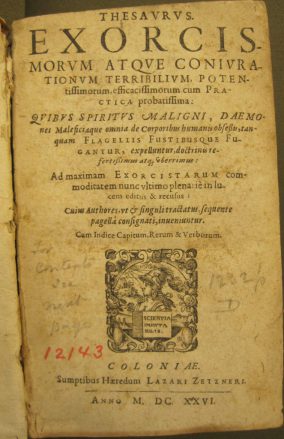Did You Know Exorcisms Aren’t Just a Bunch of Hocus Pocus?
By Emily Storz
Drexel News Blog
October 31, 2018
 Title page of a 1626 edition of the Thesaurus exorcismorum. Saint Louis University Libraries Special Collections.
Title page of a 1626 edition of the Thesaurus exorcismorum. Saint Louis University Libraries Special Collections.
Whether you are getting ready for a gory Halloween movie marathon, taking it to the streets to trick-or-treat – or priming your costume for a spooky soiree, remember, as we indulge in the spirit of make-believe and pretend, some scary traditions are based in reality — yikes! In fact, one of the scariest movies of all time, “The Exorcist,” involves the concept of exorcism, which according to Drexel history professor Jonathan Seitz, PhD, has a very real history and is even being practiced today.
Seitz’s research focuses on the historical intersections among science, medicine and religion, especially in the early modern era (roughly the 1400s-1700s). Just in time for Halloween, Seitz gave the News Blog some insight on the very real roots of a practice that seems tailor-made for horror movies.
According to Seitz, exorcism has roots in both religion and medicine. Healing clerics — calling themselves exorcists — in early, modern society were influential and often sought after to cure “spiritual” illnesses.
The United States Conference of Catholic Bishops defines exorcism as “a specific form of prayer that the Church uses against the power of the devil.” According to Seitz, its original purpose was to remove a malevolent spirit or a demon afflicting a person or a place.
Back then, exorcism was a common cure for a “spiritual illness.” In the 1500s and 1600s the professional exorcist community strove to assume an authority over the practice. Known “healers” such as Zacharia Visconti and Girolamo Menghi authored books on exorcism that included lists of symptoms and prayers. German Jesuit Peter Thyraeus authored the Daemoniaci – which listed demonic symptoms as “speaking in unknown languages and hungering for raw meat.”
Physical remedies like herbal teas, baths and anointment with holy water or herbal ointments were often used by exorcists. Thyraeus also focused on symptoms that were not demonic, such as “living an immoral lifestyle or having an unpleasant temperament.” A major goal of known healers was to be sure that people were receiving the proper treatment for their ailments.
Naturally, a wave of self-promotion began to evolve as lines between secular medicine and spiritual care began to blur and exorcists began to be viewed more like medical practitioners. “You weren’t able to charge a fee for an exorcism, however, if a patient was grateful to be cured, and made a donation or gift to the priest – it was permitted,” said Seitz.
Keep Reading at the Drexel News Blog